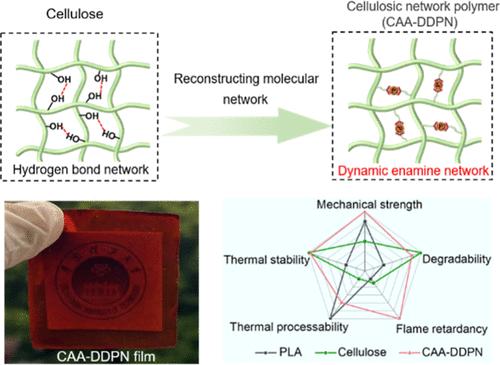通过动态共价交联制备具有内在阻燃性的可再加工和可回收纤维素网络聚合物
IF 16
1区 材料科学
Q1 CHEMISTRY, MULTIDISCIPLINARY
引用次数: 0
摘要
开发可持续、高性能的生物基材料对于减少对石油衍生塑料的依赖至关重要。纤维素是最丰富和可再生的聚合物资源,但目前的纤维素基材料在实际使用中经常受到诸如易燃性,水敏感性,有限的加工性和可回收性等限制。在此,我们提出了一种综合策略,将纤维素的氢键网络重新配置为动态共价结构,同时在原位加入阻燃单元。所得的可热加工纤维素网络聚合物(caa - ddpn)具有高拉伸强度(46-65 MPa),自熄性,耐水和普通有机溶剂。与几种工程塑料相比,CAA-DDPN薄膜具有更高的热稳定性(起始温度为281-301°C)和超低的热膨胀系数(0.9-1.8 ppm K-1)。更重要的是,动态连接剂能够有效的化学解聚来回收单体,从而克服了现有纤维素材料有限的化学可回收性。机械稳健性、热弹性和化学弹性、阻燃性和圆度的结合,使caa - ddpn成为传统石油基塑料的可行、环保替代品。本文章由计算机程序翻译,如有差异,请以英文原文为准。

Reprocessable and Recyclable Cellulosic Network Polymers with Intrinsic Flame Retardancy via Dynamic Covalent Cross-Linking
Developing sustainable, high-performance biobased materials is critical for reducing dependence on petroleum-derived plastics. Cellulose is the most abundant and renewable polymer resource, yet current cellulose-based materials often suffer from limitations such as flammability, water sensitivity, limited processability, and recyclability in practical use. Herein, we propose an integrated strategy to reconfigure cellulose’s hydrogen-bonded network into a dynamic covalent architecture while incorporating flame-retardant units in situ. The resulting thermo-processable cellulosic network polymers (CAA–DDPNs) exhibit high tensile strength (46–65 MPa), self-extinguishing behavior, and resistance to both water and common organic solvents. Compared with several engineering plastics, CAA-DDPN films demonstrate higher thermal stability (onset 281–301 °C) and an ultralow coefficient of thermal expansion (0.9–1.8 ppm K–1). More importantly, the dynamic linkers enable efficient chemical depolymerization to recover monomers, thereby overcoming the limited chemical recyclability of prior cellulose materials. The combination of mechanical robustness, thermal and chemical resilience, flame retardancy, and circularity makes CAA-DDPNs a viable, eco-friendly alternative to conventional petroleum-based plastics.
求助全文
通过发布文献求助,成功后即可免费获取论文全文。
去求助
来源期刊

ACS Nano
工程技术-材料科学:综合
CiteScore
26.00
自引率
4.10%
发文量
1627
审稿时长
1.7 months
期刊介绍:
ACS Nano, published monthly, serves as an international forum for comprehensive articles on nanoscience and nanotechnology research at the intersections of chemistry, biology, materials science, physics, and engineering. The journal fosters communication among scientists in these communities, facilitating collaboration, new research opportunities, and advancements through discoveries. ACS Nano covers synthesis, assembly, characterization, theory, and simulation of nanostructures, nanobiotechnology, nanofabrication, methods and tools for nanoscience and nanotechnology, and self- and directed-assembly. Alongside original research articles, it offers thorough reviews, perspectives on cutting-edge research, and discussions envisioning the future of nanoscience and nanotechnology.
 求助内容:
求助内容: 应助结果提醒方式:
应助结果提醒方式:


